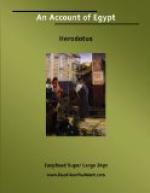The river-horse is sacred in the district of Papremis, but for the other Egyptians he is not sacred; and this is the appearance which he presents: he is four-footed, cloven-hoofed like an ox, flat-nosed, with a mane like a horse and showing teeth like tusks, with a tail and voice like a horse and in size as large as the largest ox; and his hide is so exceedingly thick that when it has been dried shafts of javelins are made of it. There are moreover otters in the river, which they consider to be sacred: and of fish also they esteem that which is called the lepidotos to be sacred, and also the eel; and these they say are sacred to the Nile: and of birds the fox-goose.
There is also another sacred bird called the phoenix which I did not myself see except in painting, for in truth he comes to them very rarely, at intervals, as the people of Heliopolis say, of five hundred years; and these say that he comes regularly when his father dies; and if he be like the painting he is of this size and nature, that is to say, some of his feathers are of gold colour and others red, and in outline and size he is as nearly as possible like an eagle. This bird they say (but I cannot believe the story) contrives as follows:—setting forth from Arabia he conveys his father, they say, to the temple of the Sun (Helios) plastered up in myrrh, and buries him in the temple of the Sun; and he conveys him thus:—he forms first an egg of myrrh as large as he is able to carry, and then he makes trial of carrying it, and when he has made trial sufficiently, then he hollows out the egg and places his father within it and plasters over with other myrrh that part of the egg where he hollowed it out to put his father in, and when his father is laid in it, it proves (they say) to be of the same weight as it was; and after he has plastered it up, he conveys the whole to Egypt to the temple of the Sun. Thus they say that this bird does.
There are also about Thebes sacred serpents, not at all harmful to men, which are small in size and have two horns growing from the top of the head: these they bury when they die in the temple of Zeus, for to this god they say that they are sacred. There is a region moreover in Arabia, situated nearly over against the city of Buto, to which place I came to inquire about the winged serpents: and when I came thither I saw bones of serpents and spines in quantity so great that it is impossible to make report of the number, and there were heaps of spines, some heaps large and others less large and others smaller still than these, and these heaps were many in number. This region in which the spines are scattered upon the ground is of the nature of an entrance from a narrow mountain pass to a great plain, which plain adjoins the plain in Egypt; and the story goes that at the beginning of spring winged serpents from Arabia fly towards Egypt, and the birds called ibises meet them at the entrance to this country and do not suffer




